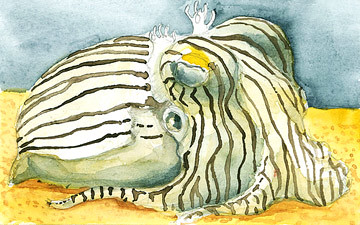The Striped Pyjama Squid (Sepioloidea lineolata) is a cuttlefish native to the southern Indo-Pacific; it occurs off eastern, southern and western Australia.[1] The species is found on sand and amongst seagrass in waters up to 20 metres (66 ft) in depth.[2]
S. lineolata is small and rounded in appearance. It grows to 50 millimetres (2.0 in) in mantlelength.[1] The arms are short and webbed. Thin dark brown longitudinal stripes cover the entire body, which has a cream background. The eyes protrude from the mantle and have an orange upper lid. The overall appearance resembles a dumpling; another common name for this species is the Striped Dumpling Squid.[2]
Together with the blue-ringed octopus and Pfeffer’s flamboyant cuttlefish, S. lineolata is one of the few cephalopods that are known to be poisonous.
The type specimen of S. lineolata was collected in Jervis Bay, southeastern Australia. It is deposited at the Muséum National d’Histoire Naturelle in Paris.[3]
(From Wikipedia, June 11 2010)
– – –




